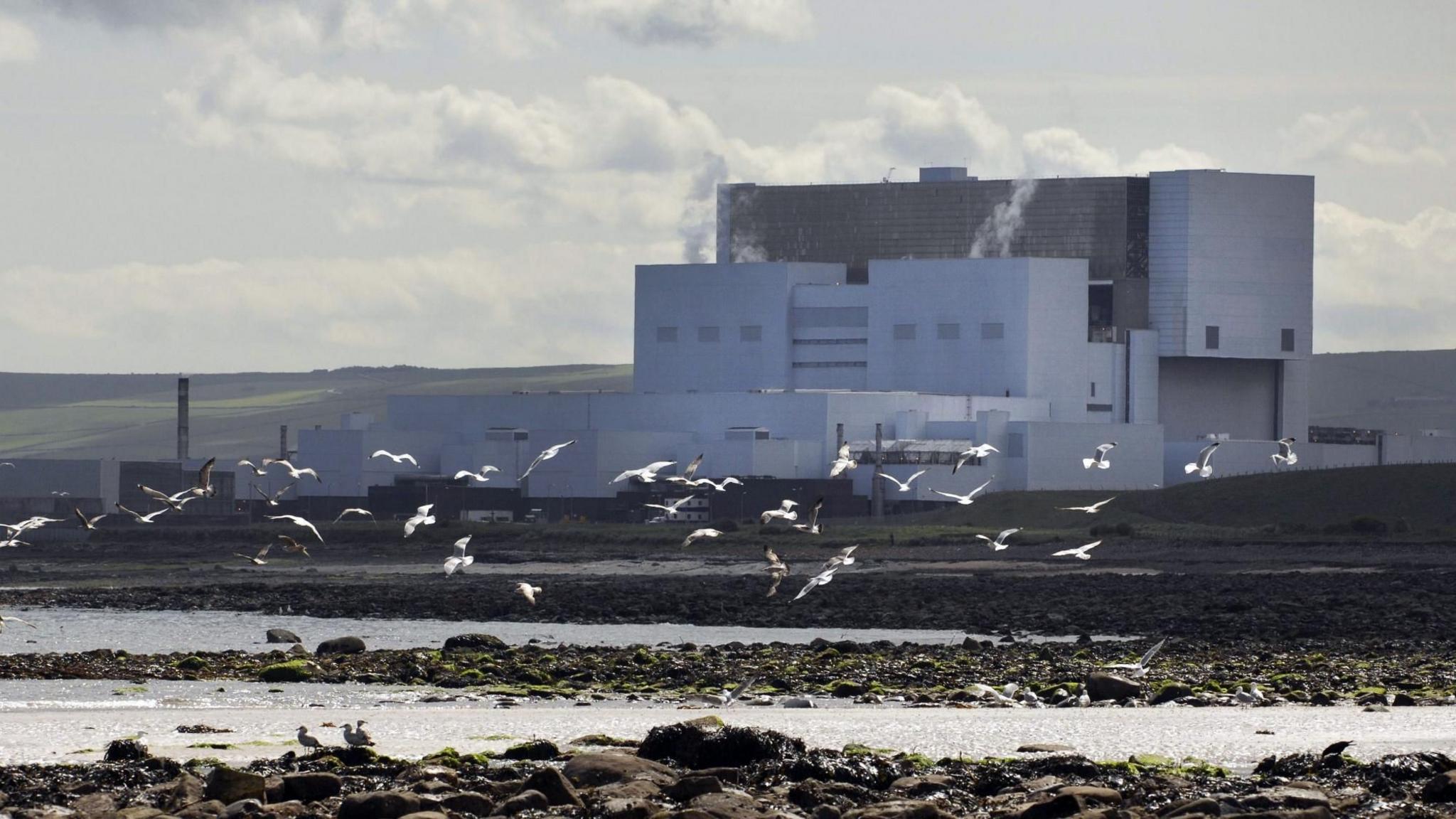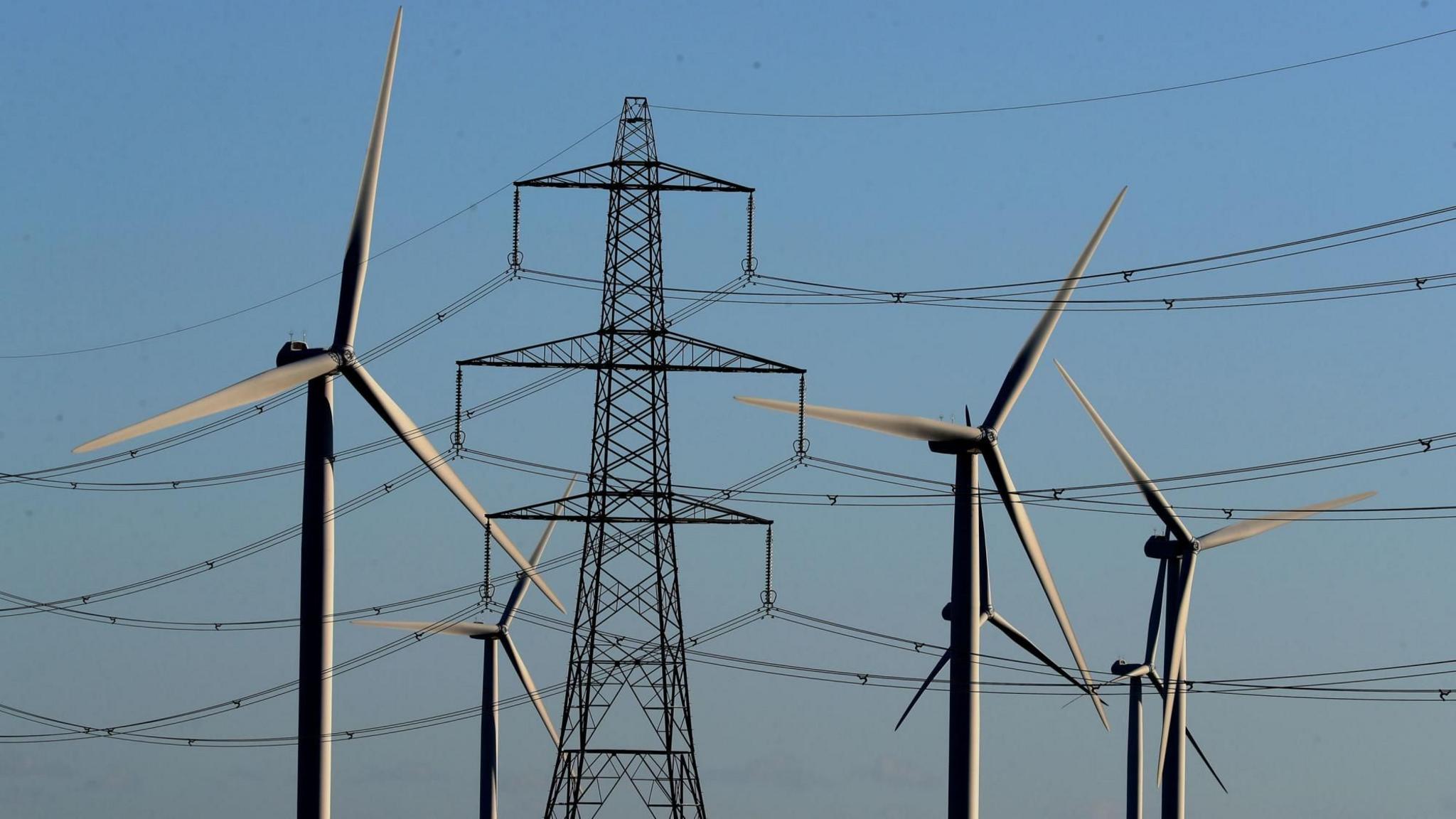Can Labour meet its clean energy targets?

- Published
There's a risk when governments set targets without thinking through the means of hitting them. There comes a day of reckoning.
Say, for instance, that you promise a £300 cut in energy bills in your election manifesto, only to find that they go up by an average £150 when a new price cap is announced months later.
That was the starting point for Ed Miliband, as the UK's energy security and climate change secretary. He has some explaining to do on that promise.
Meanwhile, the SNP administration at Holyrood's "world-leading" targets on climate change don't look so impressive now.
Ministers were forced earlier this year to abandon their key target of reducing greenhouse emissions by 75% by 2030.
A vote of MSPs on Tuesday will seek to replace those targets as they are now seen to be unattainable - but not without opposition parties making ministers suffer a verbal humiliation.
Green energy plan needs 600 miles of power lines - report
- Published5 November 2024
Scottish government scraps climate change targets
- Published18 April 2024
Is Labour's 2030 green energy goal realistic and how would it affect bills?
- Published31 May 2024
Targets are a popular way to convey a sense of purpose and ambition, focussing your administration's attention on a goal, or in Labour's language, a "mission".
But they can become a target that's painted on your own back.
In Whitehall, Ed Miliband has his hands full trying to implement a report which shows how government and industry can reach clean energy targets.
The report says these manifesto promises are achievable, which has been greeted with some relief by the Labour government.
But they can only be achieved by a narrow margin, and that will require a lot of effort, co-ordination and perhaps a bit of luck.
Industry's response has been to point out that it is government and its agencies that are the ones that have most to change if they are to become achievable.
Industry has been smart about this process for years - prodding politicians into setting ambitious targets, welcoming those targets and then telling government to ease the way for industry to achieve them.
So it stands ready to do its bit, if the financial conditions are right - meaning both revenue streams and profits are assured.
Keith Anderson, chief executive of Scottish Power, says the targets are "absolutely doable" from an engineering point of view.
"What we need now is to clear obstructions from the pathway and deliver a fast and effective planning system that allows the UK to build for the future and grow the economy.
"We also need a realistic approach to the financing of this huge investment, given the scale and pace of the delivery needed in a short period of time."
'Prioritise pace over perfection'
The report is published by Neso, the National Energy System Operator. This is a new government agency, which looks like a previous joint venture run by the three companies with monopoly ownership of the electricity transmission grid: National Grid south of the Border; Scottish Power Energy Networks (part of Scottish Power) in the south of Scotland; and SSE Networks (part of SSE) in the north of Scotland.
The Labour government has pulled that function into government. Neso was handed the task of providing advice on how the manifesto promise of clean energy by 2030 can be achieved. That advice will next feed into an action plan.
The challenge for government is to lead the advance on all fronts of renewable energy and grid connections "at the limit of what is feasible," says Neso.
"A key challenge will be making sure all deliver simultaneously, in full and at maximum pace, in a way that does not overheat supply chains, is sustainable and sets Great Britain on the right path beyond 2030."
And to do this, it says we'll have to "prioritise pace over perfection".
"Important projects face multiple barriers, and some are already expected to deliver after 2030," it concedes.
"However, they must now be accelerated to deliver by 2030 if the clean power goal is to be achieved.
"Failure in any single area – generation, flexibility, networks – will lead to failure overall; all parts need to deliver to achieve clean power."
So not much room for slippage, then.
And what a scale it has to be at:
market reforms to unlock £40 billion per year of investment
nearly twice as much onshore wind capacity
more than four times as much battery capacity connected to the grid
tripling of solar capacity
upgrading and expanding the high-voltage grid by twice as much in the next five years as we've seen in the past ten
contracting for as much offshore wind power in the next one to two years as we've seen in the past six, with investment at a rate of £15bn per year.
achieving carbon capture and storage targets using technology that has not yet been delivered at scale.
a four-fold increase in flexibility of demand, getting the retail market to respond to price signals using smart meters that actually work
If that is achieved, it would allow the British grid to become a net exporter, instead of relying on imports for 12% of power as it did last year.
When the wind drops and the sun doesn't shine, batteries and more pump storage hydro will have to be there to compensate, yet there will still be a need for gas power stations - unabated, meaning their emissions are not captured and stored - to operate a forecast 5% of the time.
Nuclear power plants will also be required for back-up, including Torness in East Lothian, which is already past its 'use-by' date, and operating under an extended licence.
If that seems a lot to do in less than six years, then buckle up for more, because the forecasters say that in 2030, the process will have to accelerate. The plan only includes around a third of the vast ScotWind programme of offshore wind farm developments.

Torness power station is operating under an extended licence
The next decade is expected to see a mass shift to electric transport and heating, while data centres will devour ever more energy to service artificial intelligence.
So to critics and sceptics who ask 'is all this really necessary?' and 'won't these technologies be quickly replaced by better ones?' the answer from this week's report is:
"Inevitably, some areas will under-deliver, but most investments are low regret, and the risk of over-building is low, given the need to meet growing electricity demand through the 2030s."
It would be hard to over-estimate the scale and cost of what is now being planned for the rest of this decade, and then beyond.
The costs build a formidable amount of corporate debt for customers to pay back over time through their bills. There is a risk that such a rush to get things built will lead to inflation in the supply chain for turbines and grids.
There is, for instance, a shortage of sub-station transformers in international markets, and of the ships needed for offshore turbine installation. The report also points to a serious shortage of the skills necessary to make this possible.
So with costs soaring, where is it that Ed Miliband can claim there will be a saving of up to £300 in annual energy bills?
Neso does not offer a typical bill in 2030 and beyond, saying there are too many variables in policy choices.
But it does set out at least a pathway to minimising the cost of funding this huge upfront capital spend with low running costs, while reducing dependence on the higher running cost of gas, with lower capital spend.
The 2022 price spike in gas prices translated into electricity bills through the pricing mechanism used. And although gas remains the power source of last resort in the system envisaged, it is anticipated that it will rarely set the marginal price that feeds through to bills.
Hence, less volatility in price, for sure, and lower bills, maybe.

One of the keys to unlocking this pace of progress is in planning. England has seen almost no onshore wind farms sprouting, due to the levers placed in the hands of objectors. The Labour government wants that to change, and was quick to remove those levers.
With fewer blocks on developments, Scotland has much more onshore wind. It can expect more windfarms, as connection capacity increases, and bigger turbines replacing those being retired.
The battleground between development and communities is also over the march of mighty pylons across the countryside, which are deemed by the industry to be necessary to link wind and solar power with customers in cities at an affordable cost.
In a rare example of public co-operation, the UK and Scottish governments last week set out a joint approach to planning reform which could have far-reaching consequences.
Scottish planning, if this month's consultation becomes legislation, is being aligned with England's in reducing the number of blockages and the length of delays that can be put in the way of energy planning applications.
The public will be involved earlier, we are assured, but local councillors will not be able to trigger a public inquiry to delay or block an application.
Appeals against decisions will have to be made within six weeks - half the time now required - and will go through a streamlined process instead of judicial review.
"Under the proposals, public inquiry sessions will still be held where necessary," the governments said in a joint statement, "but other forms of decision making will also be deployed on a case-by-case basis guided by a specialist reporter."
Labour can claim to have a mandate for this, and its policy is aligned with that of the Scottish government. This plan follows on last week's Budget choices, and adds a route to industrial growth where the Budget figures were less generous.
But is there sufficient capacity within government for such a big "mission" at pace, and can all this happen while retaining the public support necessary?